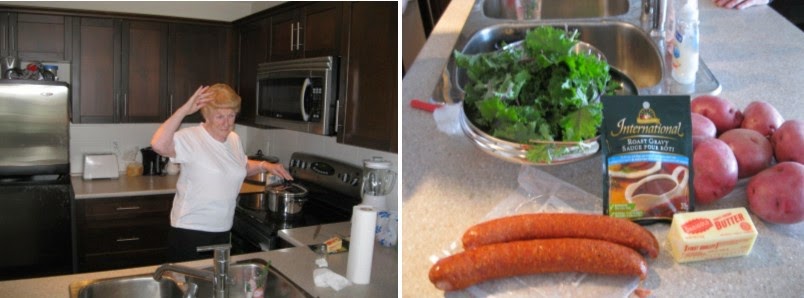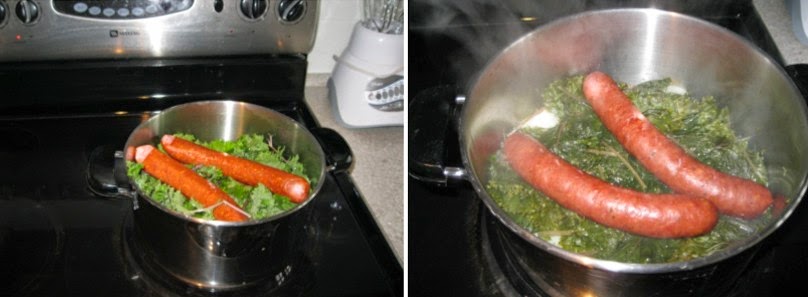 |
| Red Russian Kale |
 |
| Rotterdam after German Bombing |
Needless to say, borekole was one of the foods that "got them through it." It is easy to grow, simple to make, and sticks to your belly, making you feel "full." Did I mention it's healthy for you too? They ate a lot of it, although the recipe I am showing you today includes some variations, like mayonaise and farmer's sausage. Back then, they used vinegar and had no meat - even after the war, "meat" was a once a week thing. You didn't miss dinner on "meat night."
.
 |
| The Chef & The Ingredients |
So, anyway, onto our recipe for Dutch Kale.
Here are the ingredients and directions for the recipe we used (Serves 3-4):
6-7 Potatoes
2 x Farmer Sausage
1/4lb Butter
Gravy Mix
1 Bunch of Kale (a bunch of kale weighs approximately 3/4 of a pound, or 12oz)
Step One - Peel the potatoes and put them into a large pot.
.
.
Step Two - Add the kale on top of the potatoes
.
.
.
Step Three - Add the sausage on top of the kale - be sure to poke some holes in the sausage so it doesn't burst.
.
.
Step Four - Add water and bring to a boil over high heat. Let it cook for around 20 minutes, until the potatoes are cooked.
.
.
Step Five - Remove the sausages and drain the water, then add the butter and gravy.
.
.
.
.
Step Six - Mash it all up! Did you really need to ask why it is nicknamed "stamppot"? Ah, the Dutch. They're a pretty industrious people - but they suck at making up names.
.
.
"Stamp da pot, jonge! Stamp! Stamp! Stamp! In dat pot over der! Nowwa, what-a shoulda we call-a dis ting? Hmmmm... wait a minute... I got it... how 'bout Stamp-Pot!?!"
.
.
.
"Eet Smakelijk" (Pronounced "Ate Smack-a-lick," which means "Eat Heartily" in Dutch - it's something you wish to the others around the table after you've finished saying grace).
.
.
As you can see, the son of a landed immigrant now adds copious amounts of mayonnaise to the dish, although in the old days - and for those watching their calories - sprinkling vinegar on top is the traditional way to season it to taste.
So there you have it. It's easy to grow, easy to make, and as an added bonus, you've cooked it all in one pot so it's easy to clean up afterwards too. This was probably considered "fast food" before the invention of the microwave.
For those of you preppers out there, this is a great recipe to file away. It helped many of the Dutch get through some pretty dire times, after all.
--------------------------------------------------------
Related Posts:
.
Tips for Growing Kale
Man With A Pan Recipe List
.














No comments:
Post a Comment